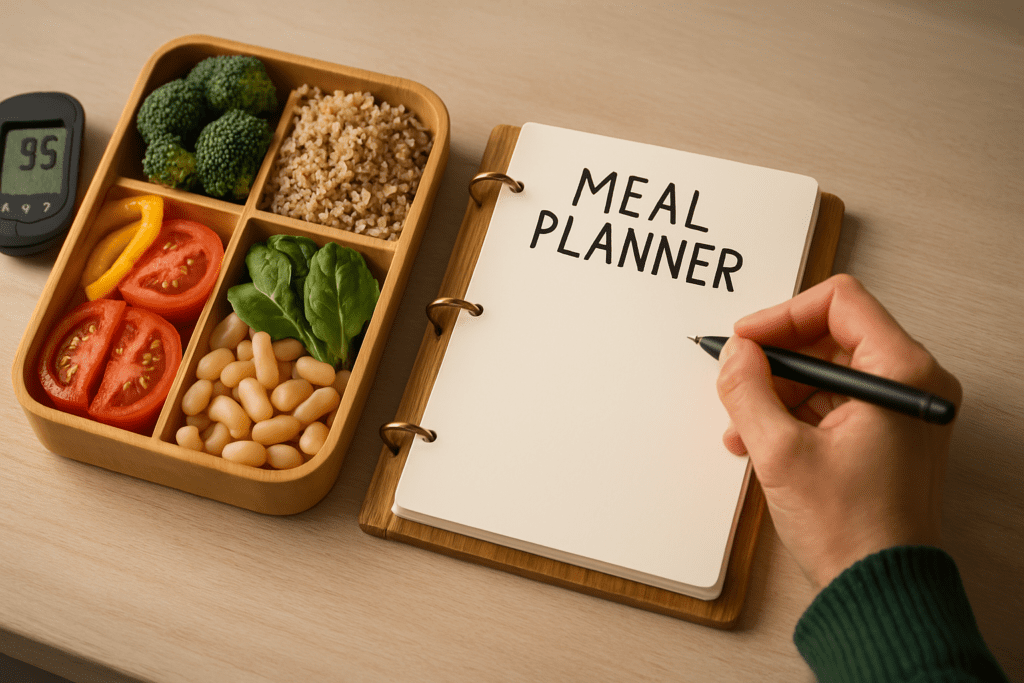Managing both diabetes and high blood pressure can be a complex challenge that requires a strategic and sustainable dietary approach. A whole-food, plant-based diet provides a powerful solution, offering nutrient-dense foods that support blood sugar control, reduce hypertension, and promote overall cardiovascular health. For individuals navigating the complexities of both conditions, knowing what to eat—and how to integrate it into daily life—is essential for long-term success. This article explores a comprehensive, evidence-based guide on the best diet for high blood pressure and diabetes, providing practical strategies and scientific insights for a healthier future.
You may also like: How a Vegan Diet Can Help Reverse Heart Disease: What the Science Says
Understanding the Link Between Diabetes and High Blood Pressure
Diabetes and high blood pressure (also known as hypertension) frequently coexist, creating a dangerous combination that significantly increases the risk of cardiovascular disease, kidney failure, and stroke. People with type 2 diabetes are more likely to develop high blood pressure due to insulin resistance, which triggers inflammation, damages blood vessels, and disrupts the balance of key hormones that regulate blood pressure. Moreover, elevated blood sugar levels lead to endothelial dysfunction, reducing the elasticity of blood vessels and promoting arterial stiffness. When these factors are compounded, the risk of cardiovascular complications skyrockets.
Research indicates that nearly 70% of adults with diabetes also have high blood pressure, highlighting the critical need for an integrated dietary approach that addresses both conditions. A well-structured diet for hypertension and diabetes not only lowers blood pressure but also improves insulin sensitivity, reduces inflammation, and protects against oxidative stress. By adopting a whole-food, plant-based eating pattern, individuals can better manage their blood glucose levels while simultaneously keeping their blood pressure within a healthy range.

The Power of a Whole-Food, Plant-Based Diet for Diabetes and High Blood Pressure
A whole-food, plant-based diet focuses on consuming minimally processed foods derived from plants, such as fruits, vegetables, whole grains, legumes, nuts, and seeds. This dietary approach emphasizes high-fiber, nutrient-rich foods while minimizing or eliminating refined carbohydrates, added sugars, and unhealthy fats. Numerous studies have demonstrated the effectiveness of plant-based diets in improving insulin sensitivity, lowering blood pressure, and reducing the risk of cardiovascular events.
One of the primary mechanisms through which a whole-food, plant-based diet benefits individuals with diabetes and hypertension is its ability to promote weight management. Excess body weight is a major contributor to both conditions, as it exacerbates insulin resistance and increases the workload on the heart. By prioritizing high-fiber, low-calorie-dense foods, individuals can achieve sustainable weight loss, leading to improved glycemic control and lower blood pressure.
Additionally, plant-based diets are rich in potassium, magnesium, and antioxidants—nutrients that play a vital role in blood pressure regulation. Potassium helps counteract the effects of sodium, reducing fluid retention and relaxing blood vessels. Magnesium supports vascular health by promoting smooth muscle function, while antioxidants combat oxidative stress, a key driver of inflammation and endothelial dysfunction.

Key Foods to Include in a Plant-Based Diet for Hypertension and Diabetes
Leafy Greens and Cruciferous Vegetables
Leafy greens such as spinach, kale, and Swiss chard are rich in potassium, magnesium, and nitrates, all of which contribute to lowering blood pressure. These vegetables are also high in fiber, which slows the absorption of glucose and prevents rapid blood sugar spikes. Cruciferous vegetables like broccoli, cauliflower, and Brussels sprouts provide powerful antioxidants that protect blood vessels and reduce inflammation. Regular consumption of these nutrient-dense vegetables can significantly improve blood vessel function and enhance insulin sensitivity.
Legumes: Beans, Lentils, and Chickpeas
Legumes are a cornerstone of a diet for high blood pressure and diabetes due to their high fiber and protein content. They have a low glycemic index, which means they cause a gradual rise in blood sugar levels, preventing post-meal glucose spikes. Legumes are also rich in potassium and magnesium, contributing to healthy blood pressure levels. Research has shown that incorporating legumes into daily meals can improve both glycemic control and blood pressure, making them an excellent choice for individuals managing these conditions.
Whole Grains for Steady Blood Sugar Control
Whole grains such as quinoa, brown rice, farro, and barley provide complex carbohydrates that are digested slowly, preventing sharp increases in blood glucose. The fiber in whole grains promotes satiety, aids in weight management, and improves insulin sensitivity. Furthermore, whole grains contain antioxidants and phytochemicals that contribute to cardiovascular health by reducing inflammation and enhancing endothelial function. By replacing refined carbohydrates with whole grains, individuals can stabilize their blood sugar levels and lower their risk of hypertension.
Berries and Other Low-Glycemic Fruits
Berries, such as blueberries, strawberries, and raspberries, are packed with antioxidants, fiber, and polyphenols that support heart health and improve blood sugar regulation. These fruits have a low glycemic load, making them an ideal choice for individuals with diabetes. Studies have demonstrated that regular consumption of berries can reduce oxidative stress, lower inflammation, and enhance insulin sensitivity. Other low-glycemic fruits, such as apples, pears, and citrus fruits, also provide valuable nutrients that benefit blood pressure and blood sugar control.
Nuts and Seeds for Heart-Healthy Fats
Nuts and seeds are excellent sources of healthy monounsaturated and polyunsaturated fats, which help reduce inflammation and improve lipid profiles. Almonds, walnuts, chia seeds, and flaxseeds provide omega-3 fatty acids that support vascular health and enhance insulin sensitivity. These nutrient-dense foods also contain magnesium and potassium, contributing to lower blood pressure. Incorporating moderate portions of nuts and seeds into a plant-based diet can enhance satiety, reduce cardiovascular risk, and improve blood glucose control.
Herbs and Spices to Enhance Flavor and Reduce Sodium
Herbs and spices such as garlic, turmeric, cinnamon, and ginger not only add flavor to dishes but also offer potent anti-inflammatory and blood pressure-lowering properties. Garlic, in particular, contains allicin, a compound known for its ability to relax blood vessels and reduce hypertension. Turmeric’s active compound, curcumin, has been shown to enhance insulin sensitivity and reduce inflammation. By using herbs and spices to season food, individuals can reduce their reliance on salt, which is essential for managing high blood pressure.

Foods to Avoid: Minimizing Risk Factors for Hypertension and Diabetes
Refined Carbohydrates and Added Sugars
Refined carbohydrates, such as white bread, pastries, and sugary beverages, contribute to insulin resistance, weight gain, and inflammation. These foods cause rapid spikes in blood sugar, leading to poor glycemic control and increased risk of hypertension. Added sugars, often hidden in processed foods, contribute to oxidative stress and vascular damage. Eliminating or minimizing these foods is essential for maintaining stable blood sugar levels and preventing further complications.
Processed and High-Sodium Foods
Processed foods, including canned soups, deli meats, and packaged snacks, are often high in sodium, which can worsen hypertension. Excess sodium intake leads to fluid retention, increasing blood volume and putting additional strain on the heart. To manage high blood pressure effectively, individuals should prioritize fresh, minimally processed foods and use herbs and spices to enhance flavor without relying on salt.
Saturated and Trans Fats
Saturated fats, found in animal products and processed foods, contribute to inflammation, insulin resistance, and atherosclerosis. Trans fats, which are found in partially hydrogenated oils and many commercially prepared snacks, further increase the risk of cardiovascular disease. A whole-food, plant-based diet minimizes these harmful fats by emphasizing plant-based sources of healthy fats that protect heart health and improve metabolic function.
Practical Tips for Transitioning to a Whole-Food, Plant-Based Diet
Start Gradually and Build Sustainable Habits
Transitioning to a whole-food, plant-based diet does not have to be an abrupt shift. Starting gradually by incorporating more plant-based meals into weekly routines can make the transition more manageable and sustainable. Experimenting with plant-based versions of favorite dishes and exploring new recipes can make the process enjoyable while ensuring a variety of nutrient-dense foods.
Plan Balanced Meals to Support Blood Sugar and Blood Pressure
A well-balanced meal should include a source of fiber-rich carbohydrates, lean plant-based protein, and healthy fats. For example, a quinoa salad with chickpeas, avocado, and a variety of colorful vegetables provides a nutrient-rich, balanced meal that supports stable blood sugar and blood pressure. Incorporating legumes, whole grains, and a variety of vegetables into each meal helps ensure a steady release of glucose and promotes satiety.
Monitor Portion Sizes and Practice Mindful Eating
Portion control plays a crucial role in managing both diabetes and high blood pressure. Eating mindfully, paying attention to hunger and fullness cues, and avoiding overeating can prevent excessive calorie intake and support weight management. Using smaller plates, focusing on nutrient-dense foods, and avoiding distractions during meals can help individuals stay on track with their dietary goals.
Scientific Evidence Supporting Plant-Based Diets for Diabetes and Hypertension
Numerous clinical studies have highlighted the benefits of plant-based diets for managing both diabetes and high blood pressure. A landmark study published in JAMA Internal Medicine found that individuals following a plant-based diet had a 34% lower risk of developing type 2 diabetes compared to those following standard diets. Another study published in Hypertension demonstrated that a diet rich in fruits, vegetables, legumes, and whole grains significantly reduced systolic and diastolic blood pressure in individuals with hypertension.
Furthermore, a meta-analysis of randomized controlled trials published in The American Journal of Clinical Nutrition concluded that plant-based diets were associated with improved glycemic control, reduced insulin resistance, and decreased cardiovascular risk factors. These findings underscore the importance of adopting a whole-food, plant-based diet as a foundational strategy for managing diabetes and hypertension effectively.
Long-Term Benefits of a Whole-Food, Plant-Based Lifestyle
Embracing a whole-food, plant-based lifestyle offers long-term benefits that extend beyond blood sugar and blood pressure management. By reducing inflammation, enhancing vascular function, and promoting a healthy weight, this dietary approach lowers the risk of heart disease, stroke, and kidney complications. Over time, individuals may experience improved energy levels, better sleep quality, and a reduced reliance on medications. Moreover, a plant-based diet is sustainable for the environment, aligning personal health with planetary well-being.
Frequently Asked Questions: A Whole-Food, Plant-Based Diet for Diabetes and High Blood Pressure
1. How does a whole-food, plant-based diet specifically help manage high blood pressure in diabetics?
A whole-food, plant-based diet provides a synergistic effect that targets the root causes of both high blood pressure and diabetes. It emphasizes nutrient-dense foods such as fruits, vegetables, legumes, and whole grains, which are naturally low in sodium and high in potassium and magnesium—two essential minerals that regulate blood pressure. Potassium helps balance sodium levels in the body, reducing fluid retention and promoting vascular relaxation. Magnesium supports vascular health by aiding smooth muscle function, improving endothelial function, and reducing oxidative stress, which contributes to hypertension. Additionally, the high fiber content in plant-based foods slows glucose absorption, preventing insulin spikes that can lead to arterial damage and inflammation. By addressing these underlying mechanisms, a plant-based diet effectively reduces the burden on the cardiovascular system while improving blood sugar control, making it an ideal diet for high blood pressure and diabetes.
2. What should a diabetic with high blood pressure eat to maintain optimal potassium and sodium balance?
For individuals managing both conditions, it’s essential to maintain a delicate balance between potassium and sodium intake to support healthy blood pressure while keeping blood sugar levels in check. High-potassium foods such as spinach, sweet potatoes, bananas, and avocados should be prioritized, as they help counteract the effects of sodium and maintain electrolyte balance. Legumes and lentils, which are also rich in fiber and protein, provide additional potassium while supporting steady blood glucose levels. Minimizing processed foods, which are often loaded with hidden sodium, is critical to preventing fluid retention and hypertension exacerbation. Additionally, incorporating herbs and spices such as garlic, turmeric, and cinnamon can add flavor to meals without increasing sodium intake, making it easier to follow a diet for high blood pressure and diabetes while maintaining optimal nutrient balance.
3. Can plant-based protein sources provide enough nutrition for people managing diabetes and high blood pressure?
Absolutely. Plant-based protein sources such as lentils, chickpeas, black beans, quinoa, and tofu provide a complete profile of essential amino acids needed for muscle maintenance and overall health. Unlike animal-based proteins, which are often high in saturated fats and cholesterol, plant-based proteins are naturally low in unhealthy fats and contain beneficial fiber that slows glucose absorption. Additionally, many legumes and grains are rich in magnesium and potassium, which help regulate blood pressure while supporting insulin sensitivity. For individuals following a diet for hypertension and diabetes, combining complementary plant proteins, such as beans and rice or hummus and whole wheat pita, ensures that all essential amino acids are met. By incorporating these nutrient-dense protein sources, individuals can meet their daily protein requirements without compromising their heart health or glycemic control.
4. Are there specific whole grains that are more effective in managing diabetes and hypertension?
Yes, not all whole grains have the same impact on blood sugar and blood pressure, making it important to choose those that provide the most benefit. Quinoa, farro, barley, and buckwheat are among the top choices for individuals following a diet for high blood pressure and diabetes. These grains have a low glycemic index, meaning they release glucose slowly into the bloodstream, preventing post-meal blood sugar spikes. Barley and oats, in particular, contain beta-glucans, soluble fibers that not only improve insulin sensitivity but also reduce LDL cholesterol and support heart health. Additionally, whole grains provide a wealth of essential minerals such as magnesium and potassium that promote vascular relaxation and help reduce hypertension. Incorporating a variety of these grains into the diet ensures steady blood sugar levels and provides the cardiovascular benefits essential for managing both conditions effectively.
5. How does fiber from plant-based foods improve insulin sensitivity and blood pressure control?
Fiber plays a dual role in managing diabetes and high blood pressure by enhancing insulin sensitivity and reducing arterial stiffness. Soluble fiber, found in foods such as oats, legumes, and flaxseeds, slows the absorption of glucose, preventing rapid spikes in blood sugar levels. This helps the body use insulin more efficiently, reducing the likelihood of insulin resistance over time. Insoluble fiber, abundant in vegetables, whole grains, and fruits, promotes healthy digestion and supports weight management by promoting satiety. Fiber-rich foods also improve endothelial function, reducing inflammation and oxidative stress that can lead to arterial stiffness and hypertension. By incorporating ample fiber from diverse plant-based sources, individuals can optimize blood sugar control while lowering their risk of cardiovascular complications associated with high blood pressure.
6. Is it possible to reduce or eliminate the need for medication through dietary changes?
For many individuals, adopting a whole-food, plant-based diet can lead to such significant improvements in blood pressure and blood sugar levels that medication may become unnecessary or reduced over time. Studies have shown that individuals who follow a diet for hypertension and diabetes rich in plant-based foods often experience a reduction in their need for antihypertensive and diabetes medications. As insulin sensitivity improves and blood pressure stabilizes, healthcare providers may gradually taper medications to avoid the risk of hypoglycemia or excessively low blood pressure. However, it’s crucial that any changes to medication are made under medical supervision to ensure safety and effectiveness. By consistently adhering to a plant-based diet, many individuals can regain control of their health and potentially reduce their dependence on pharmaceuticals.
7. What role do anti-inflammatory foods play in managing diabetes and hypertension?
Chronic inflammation is a key driver of insulin resistance and vascular dysfunction, making it essential to incorporate anti-inflammatory foods into a diet for high blood pressure and diabetes. Berries, leafy greens, fatty seeds such as chia and flaxseeds, and cruciferous vegetables like broccoli and Brussels sprouts are rich in antioxidants and polyphenols that combat inflammation at the cellular level. Omega-3 fatty acids, found in walnuts and flaxseeds, further reduce inflammation by modulating immune responses and improving endothelial function. Curcumin, the active compound in turmeric, has been shown to enhance insulin sensitivity and protect against vascular damage caused by inflammation. By incorporating these powerful anti-inflammatory foods into daily meals, individuals can not only improve their metabolic health but also prevent long-term complications associated with chronic inflammation.
8. How can intermittent fasting complement a plant-based diet for managing diabetes and high blood pressure?
Intermittent fasting (IF), when combined with a whole-food, plant-based diet, can amplify the benefits of blood sugar control and blood pressure management. IF involves cycling between periods of eating and fasting, allowing the body to reset its insulin sensitivity and reduce inflammation. During fasting periods, insulin levels drop, encouraging the body to burn stored fat and reduce excess body weight, which is a contributing factor to both diabetes and hypertension. Studies have shown that IF can improve endothelial function, enhance mitochondrial efficiency, and reduce oxidative stress, all of which play a crucial role in regulating blood pressure. When coupled with a plant-based diet, IF further optimizes blood sugar levels and cardiovascular health, creating a powerful synergy that supports long-term disease management.
9. What should a diabetic with high blood pressure eat to support kidney health?
For individuals managing both conditions, protecting kidney health is paramount, as diabetes and hypertension are leading causes of chronic kidney disease (CKD). A whole-food, plant-based diet rich in antioxidants, fiber, and anti-inflammatory compounds can significantly reduce the progression of CKD. Foods such as berries, leafy greens, and flaxseeds help protect the kidneys by reducing oxidative stress and inflammation. Reducing sodium intake through the elimination of processed foods prevents fluid retention and high blood pressure, reducing the strain on the kidneys. Additionally, plant-based protein sources, such as lentils and chickpeas, place less burden on the kidneys compared to animal-based proteins, preserving renal function over time. By adopting a kidney-conscious diet, individuals can prevent the progression of CKD while simultaneously improving their overall metabolic health.
10. Can a plant-based diet be customized to fit individual preferences and cultural traditions?
Absolutely. One of the strengths of a whole-food, plant-based diet is its flexibility and adaptability to various cultural traditions and culinary preferences. Whether someone follows a Mediterranean, Asian, Latin American, or Middle Eastern diet, plant-based foods can be seamlessly incorporated into traditional dishes while maintaining the essence of cultural flavors. Lentil-based dals, chickpea stews, vegetable stir-fries, and quinoa-based grain bowls can all be prepared with heart-healthy ingredients that support blood sugar and blood pressure control. For individuals transitioning to a plant-based diet, adapting familiar meals by substituting legumes for meat and using whole grains instead of refined grains can ease the process. This approach ensures that individuals can enjoy culturally meaningful meals while staying aligned with a diet for high blood pressure and diabetes that promotes long-term health.
Conclusion: Empowering Your Health with a Plant-Based Diet for Diabetes and High Blood Pressure
Adopting a whole-food, plant-based diet provides a powerful solution for managing both diabetes and high blood pressure, offering a sustainable path to better health. By incorporating nutrient-rich foods such as leafy greens, legumes, whole grains, berries, and heart-healthy fats, individuals can optimize blood sugar control and support healthy blood pressure levels. Avoiding processed foods, refined carbohydrates, and unhealthy fats further reduces the risk of complications, ensuring long-term cardiovascular protection.
Scientific evidence strongly supports the efficacy of plant-based diets in improving glycemic control, reducing inflammation, and enhancing vascular health. Transitioning to this dietary pattern can be a transformative journey that empowers individuals to take control of their health and reduce their dependence on medications. Through mindful eating, balanced meal planning, and gradual habit changes, individuals can experience lasting improvements in both metabolic and cardiovascular health. Ultimately, a whole-food, plant-based diet paves the way for a vibrant, healthier future, offering a sustainable solution for managing diabetes and high blood pressure with confidence and success.
plant-based diet for hypertension, heart-healthy plant foods, blood pressure-friendly meals, fiber-rich diet for diabetes, low-sodium plant-based recipes, leafy greens for heart health, legumes for better blood sugar, antioxidant-rich foods for blood pressure, nutrient-dense plant-based foods, whole grains and blood sugar control, natural ways to lower hypertension, plant-based eating for diabetes management, potassium-rich foods for heart health, healthy fats from plant sources, reducing salt with plant-based meals, diabetic-friendly whole food meals, plant proteins for heart health, anti-inflammatory plant-based diet, improving insulin sensitivity with plants, DASH diet plant-based version
Further Reading:
What superstar foods are good for diabetes?
Eating a Plant-Based Diet for Diabetes: Healthy Foods & Recipes
What to eat and avoid while on a ‘diabetes diet’
Disclaimer
The information contained in this article is provided for general informational purposes only and is not intended to serve as medical, legal, or professional advice. While NewsHealthWatch strives to present accurate, up-to-date, and reliable content, no warranty or guarantee, expressed or implied, is made regarding the completeness, accuracy, or adequacy of the information provided. Readers are strongly advised to seek the guidance of a qualified healthcare provider or other relevant professionals before acting on any information contained in this article. NewsHealthWatch, its authors, editors, and contributors expressly disclaim any liability for any damages, losses, or consequences arising directly or indirectly from the use, interpretation, or reliance on any information presented herein. The views and opinions expressed in this article are those of the author(s) and do not necessarily reflect the official policies or positions of NewsHealthWatch.

